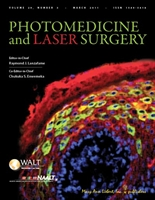BUSM’s Naeser Finds Self-Administered Light Therapy May Improve Cognitive Function after Traumatic Brain Injury
At-home, daily application of light therapy via light-emitting diodes (LEDs) placed on the forehead and scalp led to improvements in cognitive function and post-traumatic stress disorder in patients with a traumatic brain injury (TBI), according to a groundbreaking study published in Photomedicine and Laser Surgery. Read about it here.
 Together with colleagues, BUSM Research Professor of Neurology, Margaret Naeser, PhD, Lac, studied the use of transcranial LED-based light therapy to treat two patients with longstanding traumatic brain injury (TBI). Each patient applied LEDs nightly and demonstrated substantial improvement in cognitive function, including improved memory, inhibition, and ability to sustain attention and focus. One patient was able to discontinue medical disability and return to full-time work. These cognitive gains decreased if the patients stopped treatment for a few weeks and returned when treatment was restarted. Both patients are continuing LED treatments in the home. Low-level light therapy using lasers or externally placed LEDs to deliver red and near-infrared (NIR) light energy has been shown in cell-based studies to improve cellular metabolism and to produce beneficial physiological effects. In acute stroke in humans, for example, transcranial NIR light therapy applied less than 24 hours post-stroke was associated with improved outcomes.
Together with colleagues, BUSM Research Professor of Neurology, Margaret Naeser, PhD, Lac, studied the use of transcranial LED-based light therapy to treat two patients with longstanding traumatic brain injury (TBI). Each patient applied LEDs nightly and demonstrated substantial improvement in cognitive function, including improved memory, inhibition, and ability to sustain attention and focus. One patient was able to discontinue medical disability and return to full-time work. These cognitive gains decreased if the patients stopped treatment for a few weeks and returned when treatment was restarted. Both patients are continuing LED treatments in the home. Low-level light therapy using lasers or externally placed LEDs to deliver red and near-infrared (NIR) light energy has been shown in cell-based studies to improve cellular metabolism and to produce beneficial physiological effects. In acute stroke in humans, for example, transcranial NIR light therapy applied less than 24 hours post-stroke was associated with improved outcomes.
“The results of this study will provide a basis for future therapeutic use of phototherapy to improve recovery after injury and facilitate management of other CNS disorders. The development of novel therapies to restore function after neurologic injury, stroke, or disease is an increasingly important goal in medical research as a result of an increase in non-fatal traumatic wounds and the increasing prevalence of dementias and other degenerative disorders in our aging population,” says Raymond J. Lanzafame, MD, MBA, Editor-in-Chief of the Journal.
View all posts